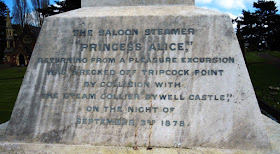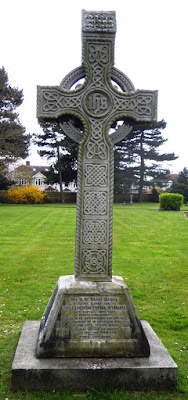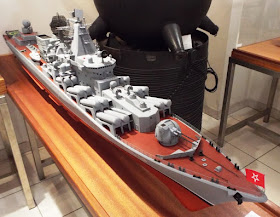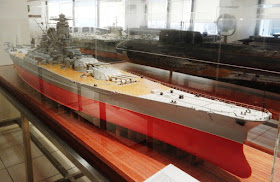Before my regular blog readers think I have gone mad, I think that I had better explain what I was doing visiting a cemetery.
I have mentioned before that my wife is a genealogist, and it just so happens that one way to find information about dead relatives is to visit cemeteries. There are quite a few of my wife's relatives buried in this particular cemetery ... so we paid it a visit.
Whilst we were there I came across three graves that are worth mentioning because of their importance in local – and even national – history
The Princess Alice Memorial
The SS Princess Alice (formerly PS Bute) was a passenger paddle steamer that operated on the River Thames as an excursion steamer. She had been built as the PS Bute in Greenock in 1865 for the Wemyss Bay Railway Company, who sold her in 1867 to the Waterman's Steam Packet Co. They renamed her Princess Alice, and she retained that name when she was sold first to the Woolwich Steam Packet Co. in 1870 and then to the London Steamboat Company in 1875.
On 3rd September 1878, she was making a routine trip from Swan Pier near London Bridge to Gravesend and Sheerness and back. Many of her passengers travelled as far as the Rosherville Gardens in Gravesend, which was a popular destination for such excursions.
At 7.40pm the Princess Alice was on her way back towards central London, and was in sight of the North Woolwich Pier, where a number of the passengers were due to disembark. At that moment the SS Bywell Castle, which was travelling empty towards Newcastle, came into view sailing in the opposite direction. The Bywell Castle was under the command of Captain Harrison, who had an experienced Thames river pilot aboard to assist him during the passage down the Thames.
The Princess Alice – which was commanded by Captain William R.H. Grinsted – was experiencing problems making progress against the tide, and turned towards the southern side of the Thames to seek the slack water ... and right into the path of the oncoming Bywell Castle. Despite ordering his engines to go astern, Captain Harrison was unable to prevent his ship slicing into the starboard side of the Princess Alice, which split asunder and sank in four minutes.
It is estimated that over 650 people died when the Princess Alice sank (there were no passenger lists, nor had a proper count of how many were aboard been taken when she set sail from Gravesend), and 120 of them were buried in a mass grave in Woolwich Old Cemetery. There were between 69 and 170 survivors, but even here the actual number of people saved was never properly accounted for.
A memorial was erected over the mass grave, and it was paid for by a national six penny subscription.
The Phipson Family Memorial
One notable memorial in the cemetery is to the members of the Phipson family. It is shaped like a Celtic Cross, and on the south side bears an inscription to the memory of Thomas Barroll Phipson of Heathfield, Plumstead and to his youngest son, Sidney Lovell Phipson, M.A., B.L.
On the north side the inscription is to the memory of Captain Temple Leighton Phipson Wybrants.
Captain Temple Leighton Phipson (he added the surname Wybrants in order to secure an inheritance after he had married into the Wybrants family) served with the 75th Regiment of Foot (The Gordon Highlanders) in Gibraltar, Mauritius and South Africa. On leaving the Army he became an explorer and a surveyor, and in 1874 he accompanied Charles Brownlee on a mission to meet Chief Kreli of the Gcalekas. (The Gcaleka are a major subgroup of the Xhosa and live in the Transkei area of the Eastern Cape. At the time of the expedition they were ruled by King Sarili ka Hintsa, whose name may well have been incorrectly recorded a Kreli.)
He became a Fellow of the Royal Geographical Society in 1878, and he died on 24th November 1880 (his 34th birthday) whilst leading an expedition to chart the land between the Zambesi and Limpopo Rivers, most specifically the Sabi River. His body was returned to England at the insistence of his mother, and it was buried in Woolwich Cemetery on 7th October 1881.
The grave of John Taylor VC
Like so many early holders of the Victoria Cross, John Taylor's grave was almost lost when the original headstone became damaged and/or indecipherable due to the action of erosion, dirt, and weathering. His has now been replaced by a new one, which is shown below.
John Taylor won his VC during the assault of Sevastopol on 18th June 1855. He was serving with the Royal Navy's Naval Brigade and held the rank of a 'captain of the forecastle'. (A 'captain of the forecastle' was a Petty Officer.) Taylor and two other men – Lieutenant Henry James Raby and Henry Curtis – left the safety of their gun emplacement to go to the aid of a wounded soldier of the 57th Regiment who was crying for help some 70 yards in front of them. Despite heavy enemy gunfire, the three men were able to carry the wounded man back to safety. For this action all three men were awarded the Victoria Cross.
John Taylor was born in the Parish of St Phillip and St Jacob, Bristol in February 1822, and died on 25th February 1857 in the Royal Marines Infirmary, Woolwich. It is worth noting that Taylor's medals included the Victoria Cross (the 86th to be awarded), the Conspicuous Gallantry Medal, the China War Medal 1842, the India General Service Medal 1854 (with clasp for Pegu), the Crimea Medal (with clasps for Inkermann and Sevastopol), the Légion d'honneur, and the Turkish Crimea Medal.
Notes:
I have mentioned before that my wife is a genealogist, and it just so happens that one way to find information about dead relatives is to visit cemeteries. There are quite a few of my wife's relatives buried in this particular cemetery ... so we paid it a visit.
Whilst we were there I came across three graves that are worth mentioning because of their importance in local – and even national – history
The Princess Alice Memorial
The SS Princess Alice (formerly PS Bute) was a passenger paddle steamer that operated on the River Thames as an excursion steamer. She had been built as the PS Bute in Greenock in 1865 for the Wemyss Bay Railway Company, who sold her in 1867 to the Waterman's Steam Packet Co. They renamed her Princess Alice, and she retained that name when she was sold first to the Woolwich Steam Packet Co. in 1870 and then to the London Steamboat Company in 1875.
On 3rd September 1878, she was making a routine trip from Swan Pier near London Bridge to Gravesend and Sheerness and back. Many of her passengers travelled as far as the Rosherville Gardens in Gravesend, which was a popular destination for such excursions.
At 7.40pm the Princess Alice was on her way back towards central London, and was in sight of the North Woolwich Pier, where a number of the passengers were due to disembark. At that moment the SS Bywell Castle, which was travelling empty towards Newcastle, came into view sailing in the opposite direction. The Bywell Castle was under the command of Captain Harrison, who had an experienced Thames river pilot aboard to assist him during the passage down the Thames.
The Princess Alice – which was commanded by Captain William R.H. Grinsted – was experiencing problems making progress against the tide, and turned towards the southern side of the Thames to seek the slack water ... and right into the path of the oncoming Bywell Castle. Despite ordering his engines to go astern, Captain Harrison was unable to prevent his ship slicing into the starboard side of the Princess Alice, which split asunder and sank in four minutes.
It is estimated that over 650 people died when the Princess Alice sank (there were no passenger lists, nor had a proper count of how many were aboard been taken when she set sail from Gravesend), and 120 of them were buried in a mass grave in Woolwich Old Cemetery. There were between 69 and 170 survivors, but even here the actual number of people saved was never properly accounted for.
A memorial was erected over the mass grave, and it was paid for by a national six penny subscription.
The Phipson Family Memorial
One notable memorial in the cemetery is to the members of the Phipson family. It is shaped like a Celtic Cross, and on the south side bears an inscription to the memory of Thomas Barroll Phipson of Heathfield, Plumstead and to his youngest son, Sidney Lovell Phipson, M.A., B.L.
On the north side the inscription is to the memory of Captain Temple Leighton Phipson Wybrants.
Captain Temple Leighton Phipson (he added the surname Wybrants in order to secure an inheritance after he had married into the Wybrants family) served with the 75th Regiment of Foot (The Gordon Highlanders) in Gibraltar, Mauritius and South Africa. On leaving the Army he became an explorer and a surveyor, and in 1874 he accompanied Charles Brownlee on a mission to meet Chief Kreli of the Gcalekas. (The Gcaleka are a major subgroup of the Xhosa and live in the Transkei area of the Eastern Cape. At the time of the expedition they were ruled by King Sarili ka Hintsa, whose name may well have been incorrectly recorded a Kreli.)
He became a Fellow of the Royal Geographical Society in 1878, and he died on 24th November 1880 (his 34th birthday) whilst leading an expedition to chart the land between the Zambesi and Limpopo Rivers, most specifically the Sabi River. His body was returned to England at the insistence of his mother, and it was buried in Woolwich Cemetery on 7th October 1881.
The grave of John Taylor VC
Like so many early holders of the Victoria Cross, John Taylor's grave was almost lost when the original headstone became damaged and/or indecipherable due to the action of erosion, dirt, and weathering. His has now been replaced by a new one, which is shown below.
John Taylor won his VC during the assault of Sevastopol on 18th June 1855. He was serving with the Royal Navy's Naval Brigade and held the rank of a 'captain of the forecastle'. (A 'captain of the forecastle' was a Petty Officer.) Taylor and two other men – Lieutenant Henry James Raby and Henry Curtis – left the safety of their gun emplacement to go to the aid of a wounded soldier of the 57th Regiment who was crying for help some 70 yards in front of them. Despite heavy enemy gunfire, the three men were able to carry the wounded man back to safety. For this action all three men were awarded the Victoria Cross.
John Taylor was born in the Parish of St Phillip and St Jacob, Bristol in February 1822, and died on 25th February 1857 in the Royal Marines Infirmary, Woolwich. It is worth noting that Taylor's medals included the Victoria Cross (the 86th to be awarded), the Conspicuous Gallantry Medal, the China War Medal 1842, the India General Service Medal 1854 (with clasp for Pegu), the Crimea Medal (with clasps for Inkermann and Sevastopol), the Légion d'honneur, and the Turkish Crimea Medal.
Notes:
- Lieutenant Henry James Raby eventually became Rear-Admiral Henry James Raby VC, CB (26th September 1827 to 13th February 1907). He was the first man to receive the VC from The Queen at the first investiture on 26th June 1857. (The Queen pinned the VCs on the recipients in strict order of Service precedence and seniority. As the by-then Commander Raby was the most senior officer of the senior service, he was given his medal first even though it was not the first to be awarded.)
- Henry Curtis (21st December 1822 to 23rd November 1896) was serving as a Boatswain's Mate at the time he won his VC.


















































